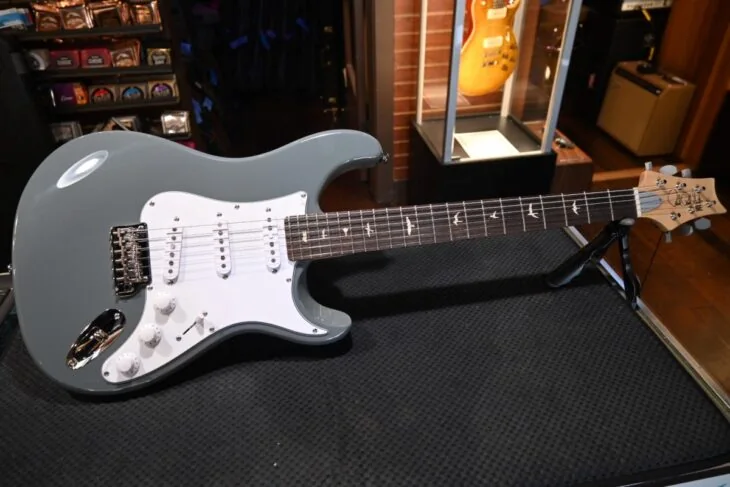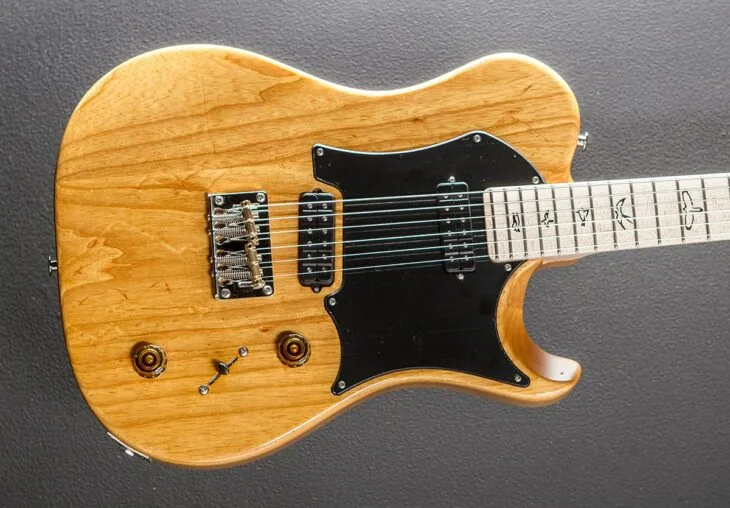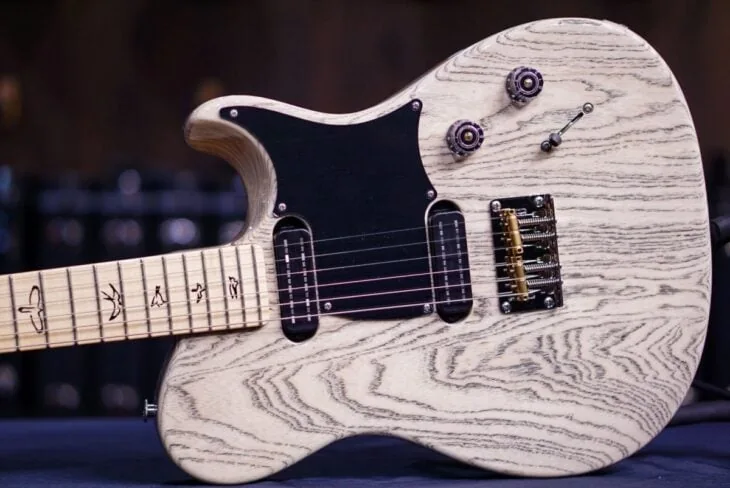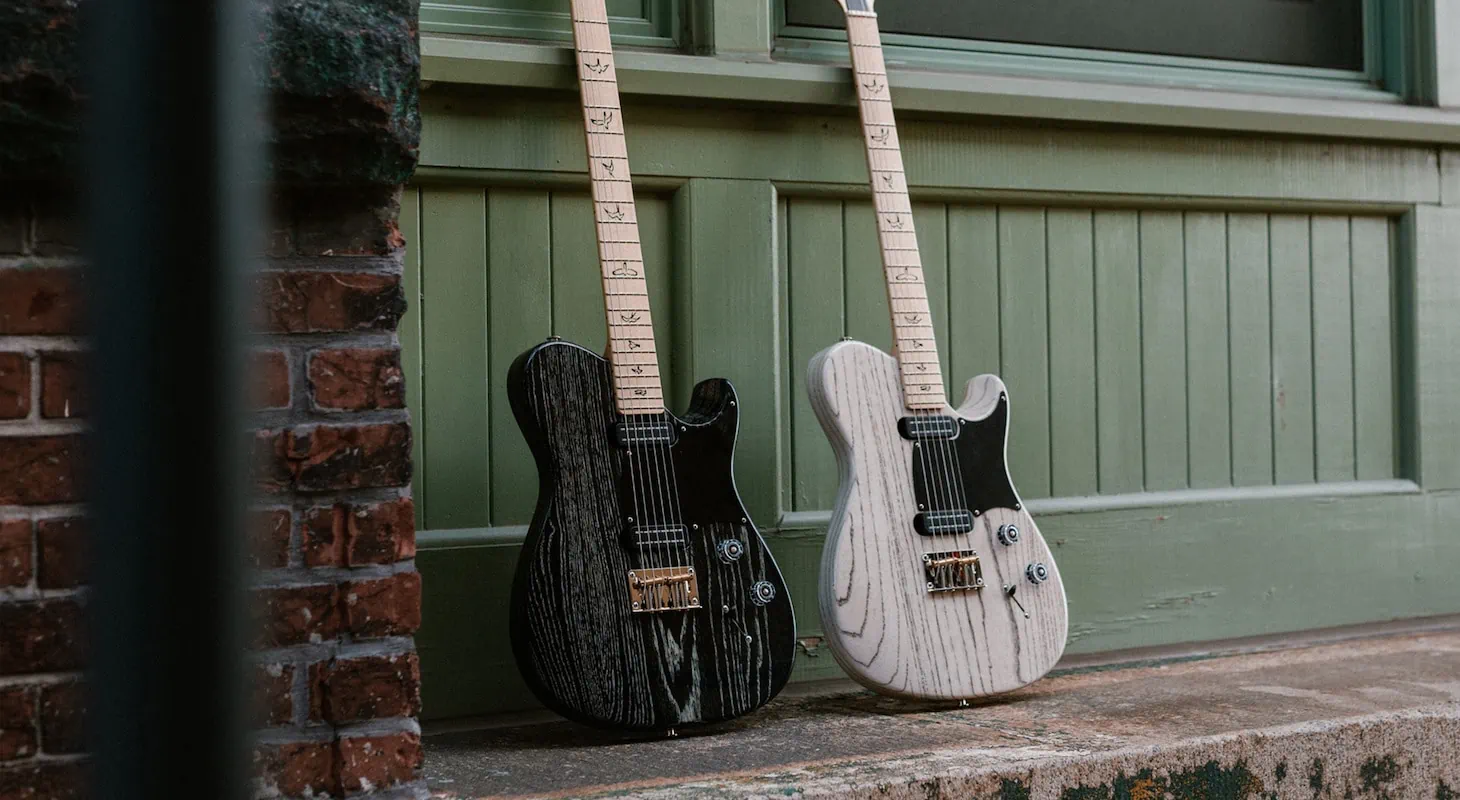It seems that Paul Reed Smith is not happy with being the third biggest brand in guitar music, he’s going after the big names. Yes, he convinced purists the size of John Mayer to make a bold move and leave the biggest guitar names behind to join his legions and fight for glory.
Unless you’ve lived inside Tupperware for the past years, you might be aware of the PRS Silver Sky and the revolution it caused in the guitar world. Indeed, Paul’s take on the Stratocaster became a great-selling instrument opening a new chapter in PRS’s history (and a whole new market).
Now, Paul has gone after the guitar that started it all for many of us, the almighty Telecaster. Let me tell you that the results are beyond impressive. Join me in this in-depth look at Paul’s latest adventure, the NF53.
Table of Contents
The Impressive Sales News

The popular site Reverb ranked the best-selling guitars in 2022, and, to the surprise of many, myself included, the PRS SE Silver Sky came out in the first position. This is not even the core model John plays live, but the more affordable alternative.
The Silver Sky is as close to a Stratocaster as you can get in a brand that’s not Fender or a subsidiary. Thus, I can’t stop singing “Your body is from a different brand” in my head when I speak about the Silver Sky.
Although last year’s Reverb sales ranking shows the SE Silver Sky on top of the list again, according to PRS, their best-selling guitars were the NF53 and the Myles Kennedy model with the Silver Sky in third position.
We can easily say, then, that Paul’s done it again. Yes, this visionary entrepreneur, star luthier, and guitar player has created a new model that can debunk all the rest and create a new audience.
Paul’s bold steps into an unknown sonic territory have proved to be the right ones again.
The Paul Reed Smith Approach
Before diving deep into the NF53 and Myles Kennedy models, let me tell you a little bit about Paul’s approach to guitar making.
In my opinion, what Paul did with PRS was to create the perfect guitar that could harness the best of the Gibson tradition and mix it with the ergonomics and playing ease of Fenders. Yes, if you take, for example, PRS’s Custom 24, his original model, it sports a Strat-shaped body with a tremolo system made of mahogany, with a maple top, and dual humbuckers.
Furthermore, Paul went as far as making his guitars with a scale that was neither Gibson (24 ¾”) nor Fender (25 ½”), but his own (25”).
This approach proved to be very good for the brand and catapulted it to the forefront of the music industry.
The NF53 and the Myles Kennedy Signature Model
Now that we’re clear about the approach behind these guitars, let’s dive into the “Telecaster” that Paul unveiled in 2023 after three years of work with the research and development department.
It is clearly a T-style body with a single cutaway but shaped closer to something like a Fender Ultra Series than to the classic ‘50s-style Tele. Also, aesthetically, the pickguard, headstock, knobs, and bridge are different. Yet, the sonic spirit and the ease of use are all there.
But don’t let me blow the scoop for you, let’s divide this guitar test into sections.
Let’s Talk Necks

The neck on the NF53 is unlike any other neck made by PRS until now. This is because of two main characteristics.
On one hand, the scale length of this guitar departs from PRS’s quintessential 25” scale and goes into Fender territory with a 25 ½” scale. This makes the guitar feel and sound more Fender-esque. The higher tension makes it more percussive.
On the other hand, the neck profile comes from a mixture of PRS neck profiles: the pattern vintage and the pattern regular. So, this new profile called “pattern 53” is unique to this model.
As a result, the neck feels very comfortable, perhaps a little on the thin side; especially at the nut. That said, the feeling you get is that you can play this guitar all day long tirelessly. Furthermore, since the radius is set at 10”, you can play chords, arpeggios, fast scales, and bend your G string to the stratosphere easily as well.
Finally, the maple cap over the maple neck along with the bone nut gives this guitar that percussive feel and tone Telecasters are so famous for. Oh, and the bird inlays sure are very cool adding mojo.
These specs are identical for the NF53 and Myles Kennedy Signature guitar.
Let’s Talk Body and Wood Types

Moving on to the guitar’s body, the guitar is made of swamp ash, a very resonant, beautiful-looking marbled tonewood. Swamp ash, mixed with the maple in the neck takes this guitar to a great-sounding midrange-rich territory that can cut through the densest mix while remaining lightweight and durable.
The paint options are great for highlighting the nuances of the wood. I think the Black Doghair, White Doghair, and McCarty Tobacco Sunburst are perfect matches for the NF53. Myles’ guitar comes in three solid colors and two see-through finishes, Tri-Color Sunburst and Antique Natural. These highlight the lines in the wood perfectly.
The body of the guitar also features the contours found in Fender’s modern lines: the relief to put our beer belly and the relief for our forearm. Furthermore, the neck joint also features a contoured heel so you can access those high frets and wail the night away.
The guitar is obviously a bolt-on neck and, perhaps my only complaint is that PRS didn’t make this a string-through-body design. In my humble opinion, having played Telecasters for close to a decade, the resonance that the string-through-body design gives to the guitar is uncanny.
I’m sure Paul had his reasons not to do it, but in my opinion, it would have made this a more resonant instrument.
Finally, one of the few but very important differences between these guitars is that the pickguard in them is different, the NF53 is smaller while the Myles Kennedy is bigger.
Let’s Talk Electronics
This is the department where things differ the most between these guitars. The NF53 sports dual Narrowfield DD pickups. These are the newest incarnations of the Narrowfield pickups, and as usual, come with a twist.
The NF53 pickups are made to be hum-canceling single-coil pickups. Yes, these were designed by Paul and the team to deliver all the bite and single-coil shimmer with none of the humming hassle. The way it works is by dividing the same amount of steel you would have in a single-coil pickup by half and placing it on opposite sides of the same pickup.
This gives the NF53 a great Telecaster sound (coupled with the swamp ash body and maple neck) with none of the problems vintage guitars have.
The Myles Kennedy guitar, on the other hand, comes with the Narrowfield MK pickups, voiced after the specifications of the guitarist and singer. According to Paul, they’re louder and wired closer to a humbucker while retaining the high-end. In Paul’s words, they’re between a humbucker and a single-coil pickup.
Again, coupled with the maple neck and swamp ash body, Myles’s signature guitar can cut through any mix, regardless of how dense it is. Myles does exactly that with Alter Bridge, live and in the studio, to make headbangers happy around the world.
But that’s not the only difference in the electronics department.
The PRS NF53 features a traditional 3-way pickup selector and single volume and tone controls. Arranged differently, but just as you would find in a regular Telecaster.
The Myles Kennedy guitar, on the other hand, features some surprises under the hood. To begin with, it features a 5-way blade pickup switcher. It also features a push/pull tone knob. What this push/pull does is reduce the tone knob to half, shaving off some of the high-end and making it more hard-rock friendly.
The five positions work as follows:
- Position 1 – Treble humbucker (with the push/pull engaged, with the tone halfway)
- Position 2 – Treble humbucker + bass coil split
- Position 3 – Treble + bass humbucker
- Position 4 – Treble coil split + bass coil split
- Position 5 – Bass humbucker (deactivates the push/pull knob if it’s up)
In this department, Myles Kennedy’s version of the NF53 is, by far, a more versatile instrument capable of adapting to a plethora of different scenarios from distorted mayhem to clean arpeggios.
Let’s Talk Hardware

The hardware in all PRS guitars is made in-house. These guitars are no exception.
They feature a bridge specially designed for them by PRS that resembles that of a regular Telecaster with brass saddles that give it a warmer tone but mounted on a steel bridge to increase the spank element.
Intonation-wise, it’s not as accurate and precise as the one you would find in a modern Telecaster, like the Fender Ultra Series, but closer to a vintage one. This is because strings are divided into dual three-string saddles that can be fine-tuned with two bolts each instead of a saddle-per-string approach.
Both guitars feature the same bridge but different tuners. While the NF53 features non-locking PRS tuners with a cool, brand-new, aged-white button design with unplated brass shafts to facilitate direct-string contact, the Myles Kennedy model features traditional PRS vintage-style locking tuners.
Let’s Talk Sounds
OK, so, enough with the technical mumbo jumbo, let’s get down to business. What do these guitars sound like?
Well, the NF53 is a guitar that’s capable of that expensive, smooth, fierce, and midrangey tone PRS is utterly well known for. Moreover, the idea of bringing together single-coil pickups with a twist, a swamp ash body, and a maple neck with a maple cap enhances that quality.
Therefore, the first thing that hits you when you start playing the NF53 is that everything sounds familiar. You’re suddenly playing a very comfortable PRS neck bolt-on a comfy, contoured single-cutaway body but you’re hearing from the amp a round, dead-silent, chimey, bright tone.
You almost have to look at the headstock twice to understand you’re not playing a Custom Shop Fender Telecaster. Yet, when you dig in and try to make a tube amp go into overdrive, what you get is a very unique-sounding bite that’s perfect to cut through any mix even playing clean.
When distorted, things get kind of nasty because of maple’s midrange and bite. It’s not a sweet-sounding guitar like a Custom 24 for example. On the contrary, it’s a take-no-prisoner approach to distortion that makes riffs sound huge and chords menacing.
The Myles Kennedy model is a much more versatile instrument because of some of the pickup choices you can make. For example, starting with the bridge pickup and the push/pull engaged, you can just add some distortion and make it sound very hard-rock-friendly without the top end being so bright.
That said, the moment you disengage that push/pull what you get is a fat and bright tone that’s closer to a P-90 than a full-on humbucker. That’s just how much it bites when pushed into high-gain territory.
Positions 2, 3, and 4 take everything to a different sonic terrain by giving you those in-between sounds we love so much in a Telecaster. I have to say that position 4 with a coil from each pickup engaged was great for playing some Rolling Stones riffs. Moreover, when you use that position with the push/pull tone knob engaged, what you get is a fatter, warmer sound that’s awesome for quiet arpeggios with some delay and reverb.
That said, you can be in high-gain territory by switching the pickup selector back and stepping on a distortion pedal.
Finally, position 5 in Myles’ signature model proved great for playing blues-inspired leads and some Santana songs. Although the maple takes away some of the sweetness that regular PRS guitars have it also introduces an enhanced midrange and high-end capable of cutting through any mix and making your leads shine loud and proud.
I can’t think of any musical style you can’t play with this guitar.
70-Year-Old Technology at Its Best
The NF53 guitar gets half its name from the pickups used: Narrow Fields (NF). The other half of the name comes from the original inspiration for this guitar. It was inspired by Paul’s favorite Telecaster, part of his personal collection, made in 1953.
This means that the technology and design behind Paul’s new adventure are based on the designs by Leo Fender made over seven decades ago.
Did Paul improve Leo’s design? Well, in my opinion, the NF53 is a more modern-sounding, more stable, and easier-to-play guitar while keeping that quintessential Telecaster mojo that makes it the chosen workhorse of the hardest-working people in the music business.
The NF53 and the Myles Kennedy model are 70-year-old technology at its very best.
Ready to Rock (& Much More!)
The NF53 and Myles Kennedy’s signature guitar are not just rocking instruments. On the contrary, they’re ready to make all sorts of music.
I know what you’re thinking, Myles plays with Mark Tremonti and Slash in heavy bands. Moreover, Myles plugs his guitar into a pair of Diezel heads. It doesn’t get much heavier than that in ampland.
Yet, the moment that Paul decided to make a bold move into the Telecaster world, he decided to create a guitar that’s capable of melting your face and haunting your heart at the same time. Yes, when playing these guitars clean, you can find some great bluesy, country, and rock-and-roll-friendly tones.
These T-Style PRS guitars are the perfect instrument to carry to any kind of session as your only electric guitar. They are pedal-friendly and go great with different amps to get different tones that go from mayhem to celestial cleans and everything in between.
Special Mention for The Owl
There’s a special mention to be made for the geometric owl that PRS put as a sign on Myles’ signature guitar. The owl comes from Myles’ solo record Ides of March (2021) and, as the singer explains, it represents wisdom and adaptability, two characteristics easily found on his signature guitar.
The Bottom End
Paul did it again. Yes, this revolutionary luthier, businessman, guitar player, and entrepreneur has released guitars to compete with the most iconic models of the biggest brands in the world. Indeed, the PRS single-cut is a challenge for Les Paul players, the Silver Sky for the Stratocaster lovers, and now the NF53 is going to try to win the hearts and hands of Telecaster players.
If this pair of guitars succeeds in debunking one of the best guitar designs in history, Paul will make history again. All we’re left with is a big question: where’s he going next? With a company like PRS and a bold genius like Paul, that question can only be answered by time.
For now, let’s hope this competition between PRS and the rest of the brands keeps on giving us quality instruments to play and enjoy.
Happy (PRS) playing!

